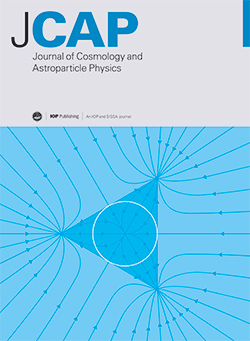Neutrino flux sensitivity to the next galactic core-collapse supernova in COSINUS
IF 5.3
2区 物理与天体物理
Q1 ASTRONOMY & ASTROPHYSICS
Journal of Cosmology and Astroparticle Physics
Pub Date : 2025-03-19
DOI:10.1088/1475-7516/2025/03/037
引用次数: 0
Abstract
While neutrinos are often treated as a background for many dark matter experiments, these particles offer a new avenue for physics: the detection of core-collapse supernovae. Supernovae are extremely energetic, violent and complex events that mark the death of massive stars. During their collapse stars emit a large number of neutrinos in a short burst. These neutrinos carry 99% of the emitted energy which makes their detection fundamental in understanding supernovae. This paper illustrates how COSINUS (Cryogenic Observatory for SIgnatures seen in Next-generation Underground Searches), a sodium iodide (NaI) based dark matter search, will be sensitive to the next galactic core-collapse supernova. The experiment is composed of two separate detectors which will respond to far away and nearby supernovae. The inner core of the experiment will consist of NaI crystals operating as scintillating calorimeters. These crystals will mainly be sensitive to the Coherent Elastic Neutrino-Nucleus Scattering (CEνNS) against Na and I nuclei. The low mass of the cryogenic detectors enables the experiment to identify close supernovae within 1 kpc without pileup. The crystals will see up to hundreds of CEνNS events from a supernova happening at 200 pc. They reside at the center of a large cylindrical 230 T water tank, instrumented with 30 photomultiplier tubes. This tank acts simultaneously as a passive and active shield able to detect the Cherenkov radiation induced by impinging charged particles from ambient and cosmogenic radioactivity. A supernova near the Milky Way Center (10 kpc) will be easily detected inducing ∼60 measurable events, and the water tank will have a 3σ sensitivity to supernovae up to 22 kpc, seeing ∼10 events. This paper shows how, even without dedicated optimization, modern dark matter experiments will also be able to play their part in the multi-messenger effort to detect the next galactic core-collapse supernova.求助全文
约1分钟内获得全文
求助全文
来源期刊

Journal of Cosmology and Astroparticle Physics
地学天文-天文与天体物理
CiteScore
10.20
自引率
23.40%
发文量
632
审稿时长
1 months
期刊介绍:
Journal of Cosmology and Astroparticle Physics (JCAP) encompasses theoretical, observational and experimental areas as well as computation and simulation. The journal covers the latest developments in the theory of all fundamental interactions and their cosmological implications (e.g. M-theory and cosmology, brane cosmology). JCAP''s coverage also includes topics such as formation, dynamics and clustering of galaxies, pre-galactic star formation, x-ray astronomy, radio astronomy, gravitational lensing, active galactic nuclei, intergalactic and interstellar matter.
 求助内容:
求助内容: 应助结果提醒方式:
应助结果提醒方式:


